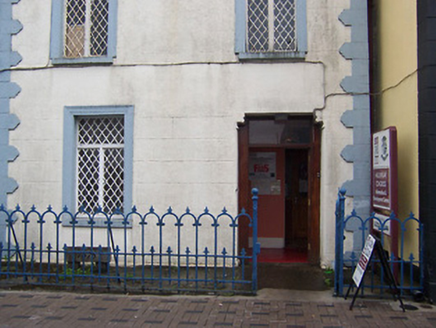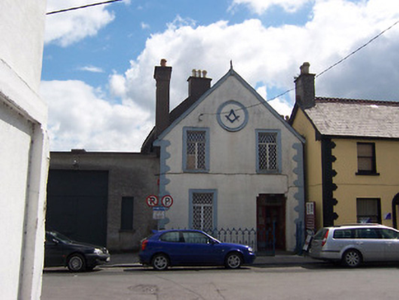Survey Data
Reg No
15310116
Rating
Regional
Categories of Special Interest
Architectural, Social
Original Use
Masonic lodge/hall
In Use As
Masonic lodge/hall
Date
1870 - 1880
Coordinates
243845, 252991
Date Recorded
07/07/2004
Date Updated
--/--/--
Description
Attached two-bay two-storey gable-fronted Masonic Hall/Lodge, built c.1878. Pitched natural slate roof, stepping up to a higher two-storey pitched roof to the rear (east). Rendered chimneystacks. Timber finial over apex of entrance gable. Ruled-and line rendered walls with raised alternating block and ‘belt-buckle’ quoins to the corners of the entrance gable. Rendered circular motif to gable apex having raised Masonic insignia. Square-headed window openings with architraved surrounds and diamond pane windows. Inset square-headed doorcase to the south end of the front façade (west) having moulded brackets, a modern timber door and a plain overlight. Set slightly back from the road to the southeast end of Church Lane with decorative iron railings with rounded heads having spikes over.
Appraisal
A simple but appealing late nineteenth-century building, which brings a different quality to the streetscape with its gable-fronted design and small diamond paned windows. This building is of particular importance due to its associations with the Masons. This building was constructed to house the Leinster Masonic Lodge No. 131, the warrant for which was first issued by the Grand Master of The Masons, the Duke of Leinster Augustus Fredrick Fitzgerald of Carton House, Kildare, in 1845. Early meetings were held in a number of the larger country houses surrounding Mullingar, including Levington Park (15401910) to the northwest. The Provincial Grand Lodge of Meath was later officially constituted by order of The Grand Lodge of Ireland in 1869 and held its early meetings at Carroll’s Hotel in Mullingar. The present building was constructed in 1878 on the site of the graveyard of St. Mary’s Priory. This building retains much of its early character and is a integral part of the built heritage and social history of Mullingar. The attractive railings to the front add incident to the streetscape and complete the setting.



